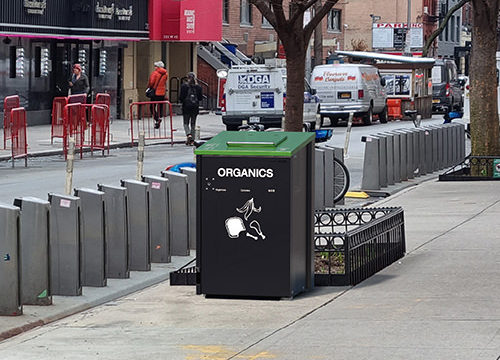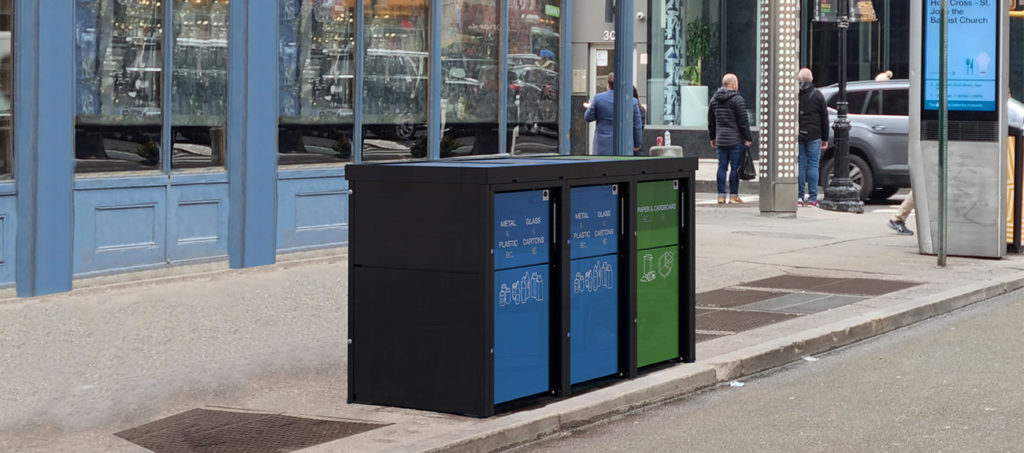
Public Space Recycling

Innovative receptacle design combined with clear, engaging communications, can reduce confusion about on-the-go recycling and make it easy for anyone to do the right thing. metroSTOR on-street recycling infrastructure has a compact, understated style, with colorful graphics making the facilities easily visible and able to stand out on busy streets.
Public Space Recycling Capacity
Many Cities don’t have the on-street infrastructure to collect and recycle the millions of pieces of food and drink packaging used every day and with the quality of waste diversion from on-the-go street locations being low, the value isnt there to collect as separate streams. Where the recycling streams that residents are accustomed to seeing are co-located in public areas as a compact single metroSTOR hub, minimizing footprint and visual impact but with the capacity for both recyclable and non-recyclable waste, this quality can improve substantially. Integral flexibility to change streams with seasonable fluctuations or changes in legislation is an advantage.
Public Space Recycling Convenience
On-the-go recycling hubs need to be located at frequent intervals on busy streets, in particular this can be close to seating areas where the majority of volume will be generated. metroSTOR R and F-Series units are slimline receptacle designs help maintain pedestrian flow when placed on narrow sidewalks. Designed for modularity, metroSTOR enables co-location of recycling bins next to general waste or use dual bins, which is a significant convenience factor and helps reduce general waste ending up contaminating recycling streams. Locks should be easy and fast to operate, and while lift-out liners are often chosen for speed of emptying in pedestrianized zones, roll-out carts provide additional capacity and reduce manual handling where adjacent to the highway.
Public Space Recycling Communication
When people are confused about what to put in the bin, ‘mixed recycling’ tends to get mixed results. Research suggests that we spend less than 2 seconds at a bin, so clear and concise instructions with visual guidance on the accepted items in each recycling stream using consistent, recognizable colors and symbols will help eliminate contamination. metroSTOR R-Series Waste & Recycling Housings can be specified with bright colors can help the bins stand out on the street with flat panels suited to local messaging that engenders greater ownership and participation. Graphics should be as high on the enclosure as possible, wrapping around the sides to maximise impact as users approach.
Public Space Recycling Consistency
On-the-go recycling receptacles clean styling to compliment the street scene, instantly recognizable for waste streams in different settings and inviting to users. metroSTOR product systems are designed for consistency with RecycleRight color panel and graphics customizable for standard color-coding, symbols and messaging used across all city communications to minimize confusion with users and consequent contamination. Repeated, positive messaging which avoids jargon is key to behaviour change.
Public Space Recycling Cleanliness
Maintaining recycling hubs in pristine condition is essential to the success of public space recycling initiatives and receptables have to be designed for resistance to damage and kept clean with minimal labor inputs, especially for the units containing food scraps.. metroSTOR R-Series recycling centres can be specified with a range of lid types including recycling stream apertures, all of which enclose the open container, preventing wind-blown litter and scavenging birds and rodents.
Find out more about metroSTOR product systems for public space recycling infrastructure and connect with our team for a metroSTOR Zero-Waste Pathway consultation